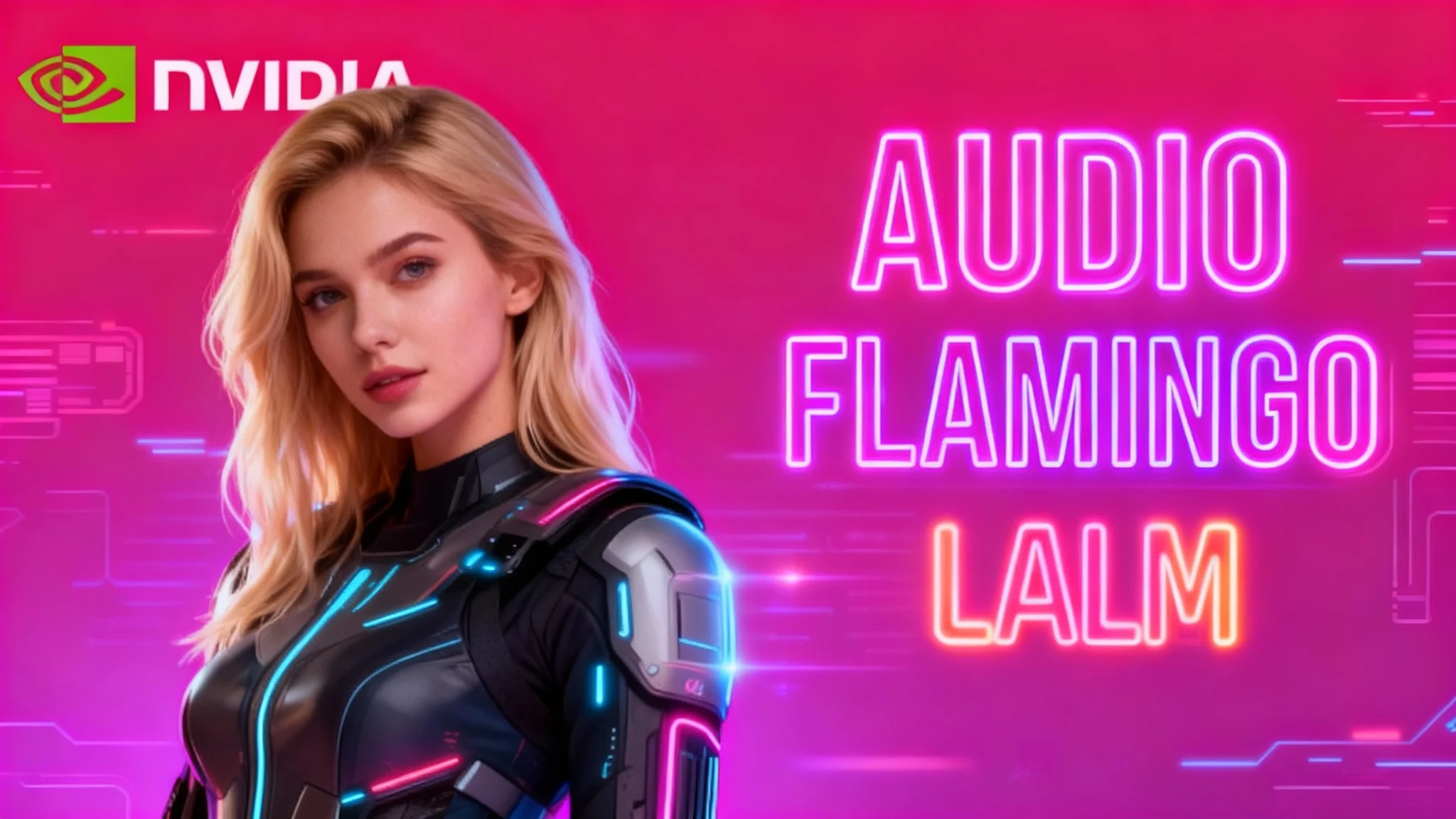NVIDIA Audio Flamingo (LALM): Demo and Setup

Table Of Content
- What is NVIDIA Audio Flamingo?
- Overview of Audio Flamingo
- Key Features of Audio Flamingo
- Running Audio Flamingo Locally
- System Used
- Step-by-Step Installation
- Launch and VRAM Usage
- How the Model Works
- Audio-to-LLM Stack
- Training Stages
- Inference Loop and Outputs
- First Local Test: Audio Reasoning
- Tone Identification with Thinking Mode
- Prompting for Tone Analysis
- Transcription and Multilingual Checks
- English Transcription
- Arabic
- Urdu and Hindi
- German
- Observations from the Session
- Practical Tips for Using the Gradio Demo
- Dataset: AudioSkills XL
- Step-by-Step: Reproducing the Session
- Troubleshooting Pointers
- Why the Architecture Matters
- Performance Notes from This Session
- Conclusion
NVIDIA has released Audio Flamingo, a large audio language model that runs locally. I set it up on Ubuntu with a single NVIDIA GPU and tested it across reasoning, tone analysis, and multilingual transcription.
Before installation, I ran a quick check: I uploaded an audio clip containing barking and music, then asked, “What is surprising about the relationship between the barking and the music?” The model replied that there is no clear relationship because they are unrelated sounds. The response was quick and accurate for this kind of audio reasoning task.
In this article, I’ll explain what Audio Flamingo is, share a concise overview and key features, then walk through installation, architecture, VRAM usage, and practical tests, including tone detection and multilingual transcription. Everything follows the same flow as my session.
What is NVIDIA Audio Flamingo?
Audio Flamingo is a fully open large audio language model designed to understand and reason about real‑world audio, including speech, environmental sounds, and music. It can handle both short clips and long recordings, up to 10 minutes.

The model supports temporal reasoning, counting, topic and attribute identification, and long-context search (needle-in-a-haystack) within audio. When prompted to “think,” it can return concise reasoning traces that explain its answer.
AF3 (Audio Flamingo 3) also includes a chat variant that supports multi-turn, multi-audio conversations and voice-to-voice interaction. NVIDIA has also released a companion dataset called AudioSkills XL.
Overview of Audio Flamingo
| Attribute | Details |
|---|---|
| Model type | Large audio language model (LALM) |
| Audio scope | Speech, sounds, music; short clips to long recordings (up to ~10 minutes) |
| Core skills | Temporal reasoning, counting, attribute/topic identification, long-audio search |
| Reasoning | Concise chain-of-thought when prompted to think |
| Variants | AF3 chat variant (multi-turn, multi-audio, voice-to-voice) |
| Dataset | AudioSkills XL |
| Local run | Yes; tested on Ubuntu |
| Demo interface | Gradio app |
| GPU memory used | ~36 GB VRAM when fully loaded |
| Test GPU | NVIDIA H100 80 GB |
| Outputs | Text answers; streaming text-to-speech for spoken replies (in chat variant) |
Key Features of Audio Flamingo
- Handles up to 10 minutes of audio with consistent reasoning across long contexts.
- Supports temporal reasoning, counting, topic and attribute identification, and targeted search within lengthy audio.
- Provides concise reasoning when asked to “think,” enabling more transparent answers.
- AF3 chat variant supports multi-turn, multi-audio dialogue and voice-to-voice interaction.
- Modular audio-to-LLM design that keeps audio understanding strong while benefiting from language reasoning.
Running Audio Flamingo Locally
I installed and ran Audio Flamingo on Ubuntu using a single NVIDIA H100 with 80 GB VRAM. The model loaded at just over 36 GB, so you’ll want a GPU with at least that much VRAM for a smooth experience.
System Used
- OS: Ubuntu
- GPU: NVIDIA H100 (80 GB VRAM)
- VRAM used by model: ~36 GB
- Environment: Python virtual environment
- Interface: Gradio app from the model repository
Step-by-Step Installation
Follow these steps from a clean terminal session:
- Create and activate a virtual environment
- Use your preferred tool. For example:
python -m venv .venv
source .venv/bin/activate- Clone the Audio Flamingo repository
git clone https://github.com/<org>/audio-flamingo.git
cd audio-flamingo- Install dependencies
pip install -r requirements.txt- Launch the Gradio demo
- From the root of the repo:
python app.py- On first launch, the model will download automatically.
Note: The initial dependency install can take time. Keep the terminal open and wait for the setup to complete.
Launch and VRAM Usage
After launching the Gradio demo, the first run downloads the model files. Once loaded, VRAM usage sits just above 36 GB on the GPU. Ensure your GPU meets or exceeds this threshold.
How the Model Works
While the dependencies install, it helps to understand the architecture. Audio Flamingo uses a modular audio-to-LLM stack so that audio processing and language reasoning remain cleanly separated.
Audio-to-LLM Stack
- AF-Whisper encoder: Converts raw waveforms into high‑level audio embeddings. This step captures relevant acoustic and semantic information.
- Audio adapter: Projects audio embeddings into the token space that the LLM understands. This allows the LLM to reason in its native token domain while still grounding in audio features.
- LLM: Performs language-based reasoning and dialogue over the projected audio features.
This modular approach keeps audio understanding strong and lets the language model handle reasoning and conversational flow.
Training Stages
Training proceeds in stages:
- Pre-training: Builds the core capabilities.
- Encoder tuning: Optimizes the audio encoder for robust acoustic representations.
- Full fine-tuning: Aligns the full stack on multi-task audio-language objectives.
- Context extension + thinking: Extends long-context handling and improves concise reasoning on request.
- Chat voice training: Teaches multi-turn interaction and voice-to-voice responses in the AF3 chat variant.
Inference Loop and Outputs
At inference:
- The audio is encoded by AF-Whisper.
- The adapter maps embeddings to token space.
- The LLM reasons and produces output.
Outputs can be text answers or streaming text-to-speech for spoken replies (in chat mode). The loop is interactive and supports multi-turn exchanges in the AF3 chat variant.
First Local Test: Audio Reasoning
I began with a simple reasoning prompt: an audio file containing barking and music. I asked: “What is surprising about the relationship between the barking and the music?” The model responded that there is no clear relationship because the sounds are unrelated. This is a straightforward but useful check on basic audio reasoning accuracy.
Tone Identification with Thinking Mode
Next, I tested tone analysis using the model’s thinking mode. In the Gradio app, I switched to the Think Long tab, turned on thinking, and added the instruction: “Please think and reason about the input audio.” Then I asked: “How would you describe the tone in audio?”
Prompting for Tone Analysis
- Tab: Think Long
- Instruction to enable thinking: “Please think and reason about the input audio.”
- Prompt: “How would you describe the tone in audio?”
The output described a vocalization that sounded playful or exaggerated, suggesting the delivery was not entirely serious. It highlighted a sarcastic or mocking tone rather than genuine surprise or excitement.
In my view, it correctly picked up a subtle undertone but missed a more obvious sensual quality present in the clip. The phrasing included a minor glitch (“not entirely serious or tone”), but the core inference landed on sarcasm or mockery rather than sincere excitement.
Transcription and Multilingual Checks
I also tested transcription and translation-style responses. These checks focused on transcription quality and language handling across English, Arabic, Urdu/Hindi, and German.
English Transcription
I provided a short spoken passage about happiness and everyday moments. The transcription was clear and accurate, capturing the content well. For English, the model performed strongly in this test.
Arabic
I supplied an Arabic clip. The model returned an English response that tracked the meaning reasonably well. A quick cross-check suggested it was not far off, though a native speaker review would give a definitive read on accuracy and nuance.
Urdu and Hindi
I tested an Urdu clip, presented in a script I couldn’t read directly. I then tried a Hindi clip. In this session, the Hindi result did not come through well. That suggests uneven performance across these languages at this time.
German
I also tried a German clip. I wasn’t able to validate it natively during the session, so I’d consider the result inconclusive without a native check. Still, the model did return a coherent response.
Observations from the Session
- Strong baseline on English transcription and reasoning. The model handled general English speech content and short reasoning prompts well.
- Arabic output looked reasonably close, but confirmation by native speakers would be ideal.
- Hindi transcription underperformed in this run, and Urdu/Hindi handling was uneven.
- Tone analysis benefited from thinking mode, which produced concise reasoning. It picked up sarcasm or mockery but missed another obvious tone component in the clip.
- VRAM requirement is significant: just over 36 GB when fully loaded on the GPU. Ensure you have sufficient memory before attempting local runs.
Practical Tips for Using the Gradio Demo
- First run will download the model—allow time for the download and initial load.
- Use the Think Long tab and include the line “Please think and reason about the input audio” to trigger reasoning traces.
- For multilingual checks, provide clean audio and, if possible, keep background noise low to improve transcription quality.
- Monitor GPU memory usage before loading long recordings; 10-minute clips fit within the model’s context but add processing load.
Dataset: AudioSkills XL
Alongside the model, NVIDIA released AudioSkills XL. This dataset supports skills such as temporal reasoning, counting, attribute/topic identification, and long-context retrieval within audio. It underpins the model’s training for both recognition and reasoning over nontrivial audio tasks, including needle-in-a-haystack searches within long recordings.
Step-by-Step: Reproducing the Session
Here is a condensed walkthrough that mirrors my session’s flow:
- Prepare your environment
- Ubuntu system with a supported NVIDIA GPU
- At least ~36 GB free VRAM (the model used just over this amount when loaded)
- Python virtual environment ready
- Install the model and requirements
python -m venv .venv
source .venv/bin/activate
git clone https://github.com/<org>/audio-flamingo.git
cd audio-flamingo
pip install -r requirements.txt- Launch the demo
python app.py- Wait for the model to download on first run.
- Ensure the Gradio interface appears and the model fully loads on the GPU.
- Run basic reasoning
- Upload an audio clip containing mixed sounds (e.g., environmental with music).
- Ask: “What is surprising about the relationship between [sound A] and [sound B]?”
- Expect a concise reasoning answer about their relationship.
- Enable thinking mode for tone analysis
- Go to Think Long tab.
- Add: “Please think and reason about the input audio.”
- Ask: “How would you describe the tone in audio?”
- Review the output for subtle tone recognition.
- Test transcription and multilingual handling
- Provide a clear English speech sample for baseline transcription.
- Try a non-English clip (Arabic, German, Urdu, Hindi).
- Compare outputs for fluency and accuracy; note any inconsistencies.
- Monitor resource usage
- Keep an eye on VRAM (~36 GB when loaded).
- Long recordings (up to 10 minutes) are supported; plan GPU usage accordingly.
Troubleshooting Pointers
- If the model fails to load: Check available VRAM; close other GPU workloads and retry.
- If language output is off: Provide cleaner audio or shorter segments, and verify the automatic language handling in the interface.
- If thinking mode doesn’t trigger: Ensure you included the specific instruction (“Please think and reason about the input audio”) and that you’re using the Think Long tab.
Why the Architecture Matters
The audio-to-LLM stack makes the system easier to reason about and tune:
- AF‑Whisper handles raw audio robustly, producing embeddings that capture both content and acoustic cues.
- The adapter bridges the gap between continuous audio features and the token space expected by the LLM.
- The LLM performs reasoning, dialogue management, and structured answering, including concise thinking traces on request.
Training in stages—pre-training, encoder tuning, full fine-tuning, and context extension—helps the model stabilize and scale to long audio while maintaining reasoning quality. Chat voice training enables multi-turn and voice-to-voice interactions in AF3.
Performance Notes from This Session
- Quick response times in the demo for short clips and reasoning prompts.
- Accurate identification of unrelated sounds (barking vs. music).
- Tone analysis improved with thinking mode but did not capture every nuance.
- English transcription rated strong; Arabic appeared close; Hindi was weak in this run; German needs native validation.
- Full model load required just over 36 GB VRAM; plan hardware accordingly.
Conclusion
Audio Flamingo offers a capable local solution for reasoning over real-world audio, handling both short and long recordings. Its modular audio-to-LLM design, thinking mode, and AF3 chat variant combine strong audio understanding with language-based reasoning and interaction.
Running it locally on Ubuntu was straightforward: set up a virtual environment, clone the repository, install requirements, and launch the Gradio app. The model downloaded on first run, loaded to just over 36 GB VRAM, and was ready for reasoning tasks, tone analysis with thinking, and multilingual transcription checks.
From this session, the model delivered solid English transcription and reliable answers on basic reasoning prompts. Tone analysis benefited from thinking mode but missed one obvious aspect in a specific clip. Multilingual results varied: Arabic looked close, Hindi underperformed, and German needs native review. Overall, it’s a practical setup for audio understanding and reasoning at local scale, with clear steps to reproduce and room to explore multilingual performance further.
Related Posts

Best AI OCR Models 2025: Use‑Case Guide & Comparison
Compare top AI OCR models for 2025. Real‑world picks on accuracy, speed, and cost for images, PDFs, and scans to text—find the best fit for your workflow.

ChatGPT Atlas vs Perplexity Comet: Our Test Winner
Hands-on testing reveals a clear winner between ChatGPT Atlas and Perplexity Comet. See the side-by-side comparison, pros & cons, and our no-hype verdict.

ChatGPT 5 vs Gemini vs Claude vs Grok: Ultimate AI comaparison
We pit ChatGPT 5, Gemini, Claude, and Grok head‑to‑head—testing reasoning, coding, and hallucinations. See the benchmarks, real results, and which AI comes out on top.
